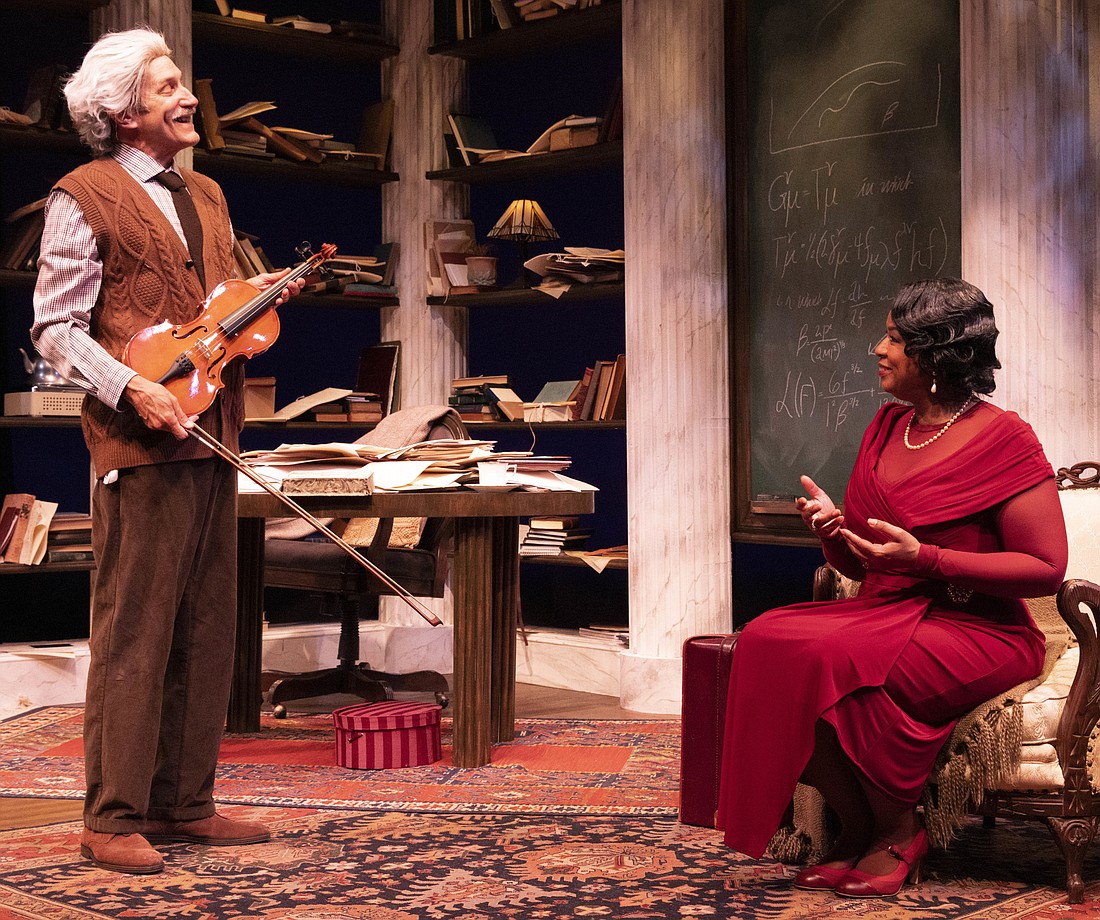- July 26, 2024
-
-
Loading

Loading

Deborah Brevoort’s “My Lord, What a Night” explores the explosive consequences that flowed from a real-life historical event. The time is 1937; the place, Princeton, New Jersey. Marian Anderson, the celebrated African-American contralto, had just performed in concert to a standing ovation. A racist insult quickly followed this honor. The whites-only Nassau Inn refused to give her a room. Albert Einstein was one of Anderson’s biggest fans. He had driven her to the hotel after her performance. After they turned Anderson away, he drove her to his home. Einstein then offered to let her stay there for the night. Anderson accepted — and a powerful chain reaction ensued.
The play begins at the moment they’ve just walked in. The sense of urgency does, too. A mob of reporters gathers on Einstein’s (aka David Edwards) front lawn. You can’t see them, but you can hear them — clamoring to come inside for a quote or a photograph. White Brainboy Opens Doors to Black Songbird! Now that’s a story! Then Einstein’s supervisor, Abraham Flexner (Rod Brogan), arrives. He wants to make sure there’s no story to print.
Flexner tries to relocate Anderson (Thursday Farrar) to the “Colored YMCA.” It seems like a craven fear of bad PR at first, but his motives go deeper. Flexner’s the head of Princeton’s Institute for Advanced Study. He’s been using that position to rescue a handful of Jewish scientists from Nazi Germany. Princeton University is still on the quota system—a racist quota that strictly limits the number of Jewish faculty members. If Einstein’s latest bleeding-heart deed grabs national headlines, the university might shut the doors to any more — refugees included.
Anderson actually considers leaving. Then Mary Church Terrell (Nehassaiu deGannes) arrives. She’s the founder of the National Association of Colored Women, and she wants the contralto to take a public stand. Will she?
The conflict boils down to a war between public and private self. On the one hand, a physicist who’s become a public figure and gleefully uses his fame to push for political change. On the other hand, a talented singer who doesn’t want to turn into a symbol, although that might give her the power to actually change things.
The play fast-forwards to 1939, the year of Anderson’s groundbreaking concert at the foot of the Lincoln Memorial in Washington, D.C. She was originally scheduled to sing at Constitution Hall. The Daughters of the American Revolution (DAR) objected because of her skin color. Her first thought is to reach out to Eleanor Roosevelt, a high-profile DAR member. (Thanks to Einstein’s friendship with the first lady, that’s possible.) She could pressure the organization to change. Mrs. Roosevelt actually resigns from the DAR. It occurs to Anderson that singing to a segregated, whites only audience is no victory, but singing in public to everybody at the foot of the Lincoln Memorial is. That sets the stage for Anderson’s groundbreaking concert — and the very public stand she takes. But that uplifting moment is undercut by dark history. Einstein, the pacifist, gets word that Hitler’s scientists are working on an atomic bomb. As much as he loathes it, he has to write to Franklin Delano Roosevelt. And tell him that America needs to build its own A-bomb first. Oy.
The acting is strong, but underplayed. These are smart, civilized individuals. Expect no shouting match. Farrar’s portrayal is very internalized. Her Anderson doesn’t wear her heart on her sleeve, and she thinks about every word before she says it. Edwards’ Einstein is a bit of an easy-going prankster, and he’s got nothing to prove. He’s very lighthearted, until some outrage stirs his sense of injustice. (He reminds me of the Silicon Valley billionaires who go around in tattered, old clothes because they can.) DeGannes’ Terrell burns with gem-like flame. Her character’s no spring chicken, but her inner conviction drives her to feats of prodigious energy — and sometimes to the point of collapse. Brogan’s Flexner is nuanced. He keeps advocating for the easy way out. He knows how weak he seems, but he’s motivated by an inner strength.
Lea Umberger’s costumes perfectly fit the characters. They range from Anderson’s precisely tailored public image on the one extreme and Einstein’s indifference to appearance on the other. Scenic designers Isabel and Moriah Curley-Clay depict Einstein’s study as a place of creative chaos. Doric columns imply classical order. But books and papers proliferate like kudzu all around them.
Kate Alexander’s direction brings order to this clash of personalities. You’re clear on where everybody stands. She maintains that clarity while strictly avoiding the artificiality of an obvious message play. Brava.
Brevoort’s script is strong. The playwright achieves that strength without hype. Her characters are real; their dialogue is never forced. If this play had been an episode on series television, they’d call it a “bottle show.” It’s a small, self-contained action in a single room, but it stands for big moments of history unfolding in the world outside. Brevoort’s captured lightning in a bottle with this play. That’s never easy. But she did it.
“My Lord, What a Night” offers an insightful glimpse at two game-changing moments in history. It’s the kind of meaty summer fare you expect at FST. But that’s not the only stage where it’s now opening. FST’s local premiere is part of the National New Play Network’s rolling world premiere at theaters nationwide now. We hope it’ll keep rolling in the future.